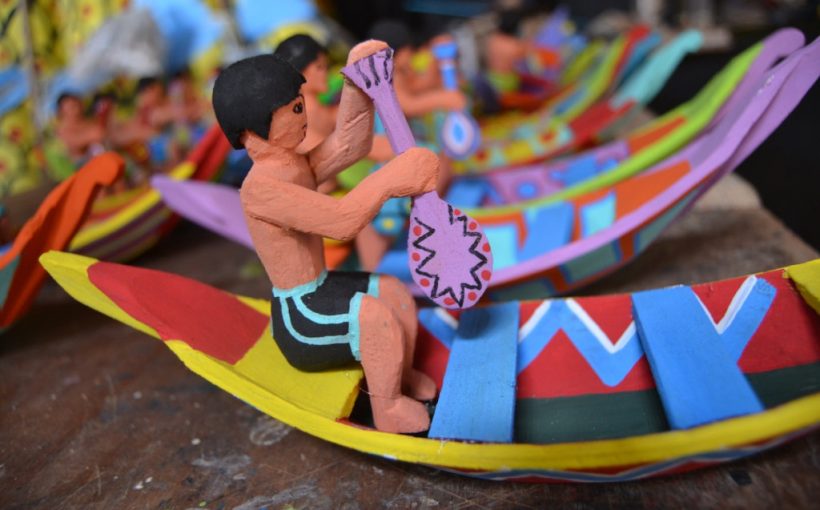Brazil’s culture has been influenced by an array of other cultures such as Indians, Africans, Portuguese, Europeans, Middle Eastern and Asian settlers. Although, their marks on the culture can be seen through the plethora of fine art creations and markets that sells crafts in the markets in the country. As history would have it, small handicrafts did not receive much recognition in Brazil, if anything they were commonly ignored by most people, regardless of their social ranks. Although, this has been changing in the last decade. These previously ignore handcrafts have been gaining popularity due to how it celebrates the culture locally while also solidifying traditions that were misplaced throughout the years form the generational lineage. Moreover, artisans have been slowly gaining more significance in Brazilian culture. The new professional of creating these small handcrafts has been giving people, mainly women, a new source in income in a job that
Category: Art & Craft
The Craft Tour of Brazil
In a recent blog we described the Gift Brazil mission, our focus is on trying to shine a light on artisan craft in Brazil and to make it available to the world. Brazil is a very big country. It is the biggest country in South America and the entire Southern Hemisphere and only Russia, the USA, Canada, and China are larger. If you got in your car in Porto Alegre in the very south of Brazil and started driving north to Belém you could keep driving for a week – assuming you stop the car to eat and sleep! But we have made a commitment to ensure we visit every state in Brazil during 2014, to meet local artisans and to work with the local artisan associations so we can personally find some great craft from all across this enormous nation. It will be a challenge because many parts of the country are impassable
Apiaí: reinventing pottery
As part of Gift Brazil’s Great Craft Tour, we visited Apiaí, a small town located 320km from São Paulo city surrounded by lush Atlantic rainforest and one of the most important and traditional pottery hubs in southeast Brazil. Apiaí wants to make its priviledged location and outdoor activities more known to tourists, that is not what we came for: we wanted to know more about the the pottery history in the town and the people making it, employing a mix of techniques inherited by indigenous tribes and African slaves. During the eighteenth century, the region surrounding Apiaí – also known as the Ribeira do Iguape Valley, or simply Rbeira Valley – was populated by former African slaves that had been freed or escaped their captivity. The fugitives then married local women and became farmers, who also produced their own clay pots, crockery and decorative objects. Way before the African slaves arrived,

Craft brings hope to Jequitinhonha Valley
There is a major stigma of poverty and serious social, economic and environmental problems in the Jequitinhonha Valley. But the region, despite all its difficulties, is also one of the richest of Brazil in terms of culture and craft production. Located in the northern state of Minas Gerais, the Valley is home to some 80 small towns that in the heyday of mining attracted immigrants from all over the country, after the wealth of mineral resources in the area, including gold and diamonds. Today, centuries after all the predatory mining that took place, the region suffers badly with lack of opportunities. The typical drought and blazing sunshine does not make things easier for the local families – husbands often have to seek farming work in other places during the dry season, which can last as long as eight months. Faced with the arduous job of looking after the home and
Caning unites craft and architecture in Brazil
We have already talked about the cobogó, the ever-present concrete feature created in Brazil back in the 1920s as a solution to ventilate rooms, nowadays a decorative item in its own right and available in many graphic variations. When we found an example where cobogó met caning, we loved it even more. São Paulo-based architect Cícero Ferraz da Cruz created a new type of cobogó inspired in the chair weaving patterns of caning resulted in a project that unites two elements full of Brazilian character. The cement pieces formed the beautiful panel of 5 x 6m seen above, now on display at Farm, a Brazilian womenswear chain, where caning was also used for the shop façade. Caning, a traditional type of chair-weaving craft deriving from peeled bark or skin of the rattan vine, is very commonly seen in Brazil as a main feature of chairs, tables, bed headboards and other items. The

The Arraiolo rugs of Diamantina
The Minas Gerais city of Diamantina was a center of European culture with a thriving economy during Brazil’s colonial period. Gold and diamonds attracted hordes of explorers from all parts of Brazil and beyond. However, once the mines were depleted, work opportunities were few and far between – similarly to what has happened in the nearby Jequitinhonha Valley. Also in Diamantina, craft played a very important role in the local economy. The wool rugs of Arraiolos, a small town in Portugal, are made with a needlework style that is inspired by Persian carpets, since the Middle Ages. But it wasn’t until quite recently that this craft style became known – and made – in Brazil. Known simply as “tapete arraiolo” in Brazil, the rug-making technique was introduced in the 1970s through to an initiative of the then archbishop of Diamantina, who sought to create work for the impoverished housewives of the region. Maria de Fátima

Craft, poverty and social change in Brazil
Brazil is a very unequal society. In big cities like São Paulo, it is possible to walk down a street filled with Chanel and Louis Vuitton shops that are more expensive than they are in Europe and then to turn a corner to find someone living in a shack built on the street. According to the World Bank, there are only 12 countries in the world that have a worse distribution of income. The World Bank uses a measurement called the Gini coefficient to measure income inequality – put simply, if every person in a country has the same income then the Gini would be 0 and if one person has all the cash then the Gini would be 1. The Gini coefficient is usually multiplied by one hundred so that it can be written as a percentage. So to give you an idea of the various scores, Denmark is the most

The toy makers from Abaetetuba
Softly-spoken Pirias is busy. He is preparing several items to take to a market and still needs to prepare for a workshop he will be hosting in a city that is hundreds of miles away from his hometown of Abaetetuba, in the state of Pará, extreme north of Brazil. Still, the artisan, real name José Plácido da Silva, finds a bit of time to chat to us. Abaetetuba is the home of toys made out of the pulp of miriti, a palm native to the north of the country and Pirias is the most recognized representative of this kind of craft in the whole of Brazil. The toy maker credits his fame and recent success – which includes a host of exhibitions and workshops across Brazil, as well as being picked as one of the few artisans to represent his state in the shops set up by the government during the

Brazilian craft we can only admire
At Gift Brazil, we aim to make genuine Brazilian artisan art and craft available to the world. This means that our team is always on the road, all over Brazil meeting with artisans and encouraging them to join our collective. Recently we were up in the extreme north of Brazil in Belém. Then we went to the extreme west of the country in the Pantanal, the largest tropical wetland in the entire world – very close to the border with Bolivia. Some of the artisans we meet are in very remote places, but we don’t have many requirements for including someone in the collective – the main requirement is that they are producing interesting products that we would like to showcase online! Sometimes, we meet artisans that produce great work, but we just cannot include them in the Gift Brazil collective because they don’t use email or other basic technologies. All orders